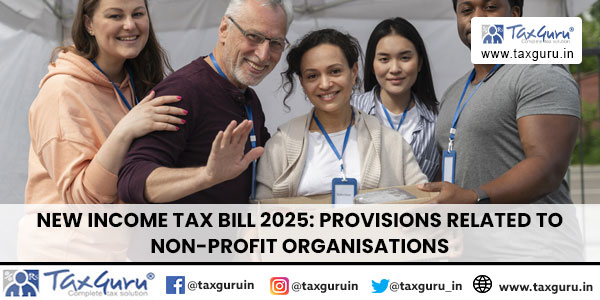Summary: The New Income Tax Bill, 2025 simplifies and consolidates the income tax provisions for non-profit organisations. It combines various scattered provisions into Part B of Chapter XVII, covering registration, income, commercial activities, compliances, violations, eligibility for donations, and interpretations. The term ‘registration’ replaces ‘approval,’ and ‘registered non-profit organisation’ refers to entities with valid registration under Sections 12A, 12AA, 12AB, or 10(23C) of the Income-tax Act, 1961. The Bill clarifies the concepts of ‘tax year’ and ‘financial year’ and simplifies the accumulation of income provisions. It aims to make the rules easier to understand and comply with by removing redundant provisions and reducing cross-references.
1. Meaning of Non-Profit Organization:
In the current Income-tax Act, various organizations engaged in charitable activities, as defined in Section 2(15) of the Income-tax Act, are referred to by different terminologies such as Educational Institutions, Universities, Hospitals, Charitable Trusts, etc. Now, all these entities will fall under the nomenclature of Non-Profit Organisations.

2. Existing Number of Taxpayers (Charitable Trust):
According to data from the Income Tax Department, by November 30, 2024, 2,50,682 entities filed their returns for the assessment year 2023-24. During the financial year 2022-23, these entities spent an amount of ₹10.01 lakh crores on charitable and religious purposes.
3. Reasons for Simplification:
In the current Act, provisions related to charitable trusts are spread across multiple chapters. These include the definition of charitable activity in Section 2(15), Exemptions for certain educational institutes and Hospitals in Section 10(23C), Other charitable activities covered in Sections 11 to 13. Exemptions for donors in Section 80G, and Anonymous donations Section 115BBC, Taxation of specified income Sections 115BBI, and taxation of accreted income in Section 115TD, 115TE, and 115TF.
These scattered provisions, along with frequent amendments, numerous cross-references, explanations, and provisos, have made the Act difficult to understand. For instance, Section 11 alone has 13 explanations and 16 provisos, complicating comprehension.
The new Bill has revamped provisions for non-profit organisations to simplify and consolidate the rules to make the income tax provisions related to trust activities easier to understand and comply with. The provisions have been simplified. Redundant provisions have been removed, and some provisions have been tabulated for clarity.
It consolidates all provisions into Part B of Chapter XVII, titled “Special Provisions for Registered Non-Profit Organisations.” This chapter divides provisions for non-profit organisations into seven sub-parts covering registration, income, commercial activities, compliances, violations, eligibility for donations, and interpretations.
4. Arrangement of New sections/Clauses in the Bill
Key sections/clauses that relate to the taxability of non-profit organisations:
i) Clause 332: This clause provides guidelines for the registration of non-profit organisations and the conditions for tax exemptions.
ii) Clause 333: This clause outlines the taxability of income for non-profit organisations, including the conditions under which income is exempt from tax.
iii) Clause 334: This clause details the taxability of income in case of violations by non-profit organisations.
iv) Clause 335: This clause specifies the rules for the accumulation of income by non-profit organisations and the conditions under which such accumulations are allowed.
v) Clause 336: This clause addresses the taxability of specified income and the conditions under which it is taxed.
vi) Clause 337: This clause provides the rules for the application of income by non-profit organisations and the conditions for tax exemptions.
vii) Clause 338: This clause outlines the taxability of accreted income in case of violations or non-compliance by non-profit organisations.
5. Registration of Charitable Trust:
The term ‘registration’ replaces ‘approval’ to avoid confusion. The word ‘registration’ in the Bill refers to both ‘approval’ (as used in existing Section 10(23C)) and ‘registration’ (in existing Section 12AB). It includes provisional registration, provisional approval, or approval (under proposed section 332), excluding the approval provision in Section 80G (under proposed section 354).
In the present Act, the provisions related to registration contain several cross-references. In the proposed section 332(3) of the Income Tax Bill, 2025, a tabular format has been provided mentioning the time limits for furnishing applications, time limits for passing the order, and the validity of registration in different cases in a very simple and lucid manner.
A ‘registered non-profit organisation’ is any entity with valid registration under Sections 12A, 12AA, 12AB, or Section 10(23C) of the Income-tax Act, 1961, as long as the registration hasn’t been cancelled. This term helps avoid confusion and makes it easier to understand the Bill’s provisions.
6. Structure of new Part XVII-B –
The entire Part related to non-profit organisations has been divided into 7 sub-parts which contain the provisions related to registration, income, commercial activities, compliances, violations. registrations for the purposes of eligibility of donations and interpretations.
i) Registration of Non-Profit Organisation:
-
- Application for registration
- Switching over of regimes
ii) Income
-
- Tax on income of a registered NPO
- Regular Income Taxable Regular Income
- Specified income
- Income not to be included in total income
- Corpus donation
- Deemed corpus donation
- Application of Income
- Accumulation of income
- Deemed Accumulation of Income
iii) Commercial activities
-
- Business undertaking held as the property
- Commercial activities by a registered NPO
- Commercial activities by registered NPO with General Public Utility
iv) Compliances
-
- Books of account
- Audit
- Return of income
- Permitted Modes of Investments
v) Violations
-
- Specified violation
- Tax on accreted income
- Other Violations
vi) Approval for donations (Old 80G)
vii) Interpretations
7. Condition related to Application of 85% of Income:
There is no change in the taxability of the income of Non-Profit Organisations if they apply 85% of their regular income for charitable or religious purposes as per existing provisions. However, if the organisation fails to apply 85% of its income or accumulate it, then the amount of income which falls short of 85% will be taxed unless the organization opts for accumulation towards its objects.
8. Taxability of Capital Gain:
In the new tax Bill, specific provisions (exemption) for the treatment of capital gains in the case of charitable trusts have been omitted. Under the existing Section 11(1A), charitable trusts could claim exemption on capital gains if the net consideration from the transfer of a capital asset was utilized to acquire another capital asset. This mechanism allowed trusts to reinvest proceeds from asset transfers without incurring tax liabilities on the gains, provided the reinvestment was for charitable purposes.
With the omission of Section 11(1A), the specific exemption for reinvested capital gains is no longer available. It implies that entire receipts by way of the transfer of capital assets by charitable trusts are now considered part of the trust’s income. To claim exemption under Section 11, the trust must apply at least 85% of this income towards its charitable or religious purposes during the previous year, or they need to accumulate for future application.
9. Provision related to Accumulation of Income:
Under the existing Act, two types of accumulations are allowed. First, Section 11(2) allows accumulation for up to five years, and second, as per Explanation 1(2) to Section 11(1), which allows deemed application for certain reasons, usually for one year if the income is not received. These dual provisions were causing implementation and interpretation issues.
The provisions for deemed application under Explanation 1(2) to Section 11(1) have been simplified to reduce litigation and make compliance easier. Under the proposed Section 342 of the Bill, accumulations can be made for any purpose specified in the prescribed form.
10. Concept of Tax Year and Financial Year:
The term ‘financial year’ is not defined in the Income-tax Bill or the 1961 Act. It is defined in the General Clauses Act, 1897, as the year starting on April 1st. The term ‘financial year’ is used in the Bill, such as in Section 21(5) for a completion certificate of a building held as stock-in-trade.
A ‘tax year’ is a twelve-month period within a financial year. It replaces ‘previous year’ from the 1961 Act. The term ‘assessment year’ is no longer used. ‘Tax year’ is now used for income tax rates and assessments. The terms ‘previous year’ and ‘assessment year’ caused confusion, so ‘tax year’ is used instead. ‘Financial year’ is still relevant for procedural actions.
However, a ‘tax year’ can be less than a financial year. This happens when a trust starts its activity during a financial year. The tax year starts from the setup date and ends on the last day of that financial year.
The concept of the assessment year is still valid. The Assessment Year 2025-26 of the Income-tax Act, 1961, will pertain to the income of a taxpayer for the financial year 2024-25. The new Act will be implemented from April 1, 2026, which means it is applicable for the income earned in FY 2026-27, and the relevant assessment year is 2027-28.





